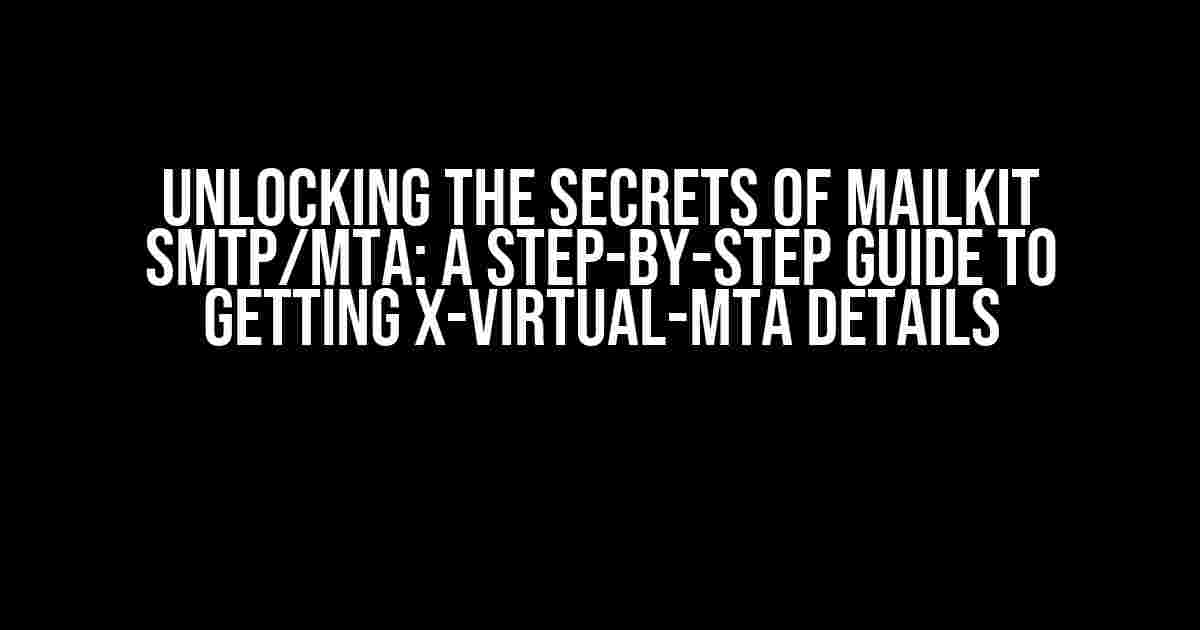Are you tired of feeling like you’re stuck in a digital black hole, struggling to uncover the mysteries of Mailkit SMTP/MTA? Look no further! In this comprehensive guide, we’ll delve into the world of X-Virtual-Mta details and provide you with a clear, easy-to-follow roadmap to getting the information you need.
What are X-Virtual-Mta Details?
Before we dive into the nitty-gritty, let’s take a step back and understand what X-Virtual-Mta details are. In simple terms, X-Virtual-Mta is a Mailkit SMTP/MTA header that contains vital information about the virtual MTA (Mail Transfer Agent) used to process an email. This information can be crucial in troubleshooting email delivery issues, tracking message routing, and identifying potential security threats.
Why Do You Need X-Virtual-Mta Details?
So, why is it essential to obtain X-Virtual-Mta details? Here are a few compelling reasons:
- Troubleshooting Email Delivery Issues: When emails get stuck or bounce back, having X-Virtual-Mta details can help you identify the root cause of the problem.
- Tracking Message Routing: By analyzing X-Virtual-Mta details, you can trace the path an email takes from the sender to the recipient, helping you optimize email infrastructure.
- Security Enhancement: X-Virtual-Mta details can reveal potential security threats, such as email spoofing or phishing attempts, allowing you to take proactive measures to protect your email ecosystem.
Getting X-Virtual-Mta Details: A Step-by-Step Guide
Now that we’ve established the importance of X-Virtual-Mta details, let’s get down to business! Here’s a step-by-step guide to help you retrieve these vital details:
Step 1: Install Mailkit and Set Up Your SMTP Server
Before you can start retrieving X-Virtual-Mta details, you need to set up your Mailkit SMTP server. If you haven’t done so already, follow these steps:
- Install Mailkit using NuGet or by downloading the package from the official website.
- Configure your SMTP server by setting up the necessary credentials, such as username, password, and host.
- Enable SMTP logging to capture email transactions.
Step 2: Send an Email Using Mailkit
To retrieve X-Virtual-Mta details, you need to send an email using Mailkit. Here’s an example of how to do it:
using Mailkit.Net.Smtp;
using Mailkit.Security;
// Set up your SMTP client
var client = new SmtpClient();
// Connect to your SMTP server
client.Connect("your-smtp-server.com", 587, false);
// Authenticate using your credentials
client.Authenticate("your-username", "your-password");
// Compose and send an email
var message = new MimeMessage();
message.From.Add(new MailboxAddress("Your Name", "[email protected]"));
message.To.Add(new MailboxAddress("Recipient Name", "[email protected]"));
message.Subject = "Test Email";
client.Send(message);
// Disconnect from the SMTP server
client.Disconnect(true);
Step 3: Retrieve X-Virtual-Mta Details from SMTP Logs
Now that you’ve sent an email using Mailkit, it’s time to dig into the SMTP logs to retrieve the X-Virtual-Mta details. You can do this by:
- Checking the SMTP log files for the email transaction.
- Searching for the X-Virtual-Mta header in the log files.
- Extracting the X-Virtual-Mta details from the header.
Here’s an example of what the X-Virtual-Mta header might look like:
X-Virtual-Mta: mail-relay.example.com (Policy-Server-UUID=12345678-abcd-1234-abcd-1234567890ab; Protocol-UUID=12345678-abcd-1234-abcd-1234567890ab; Virtual-MTA-UUID=12345678-abcd-1234-abcd-1234567890ab)
Decoding X-Virtual-Mta Details
Now that you’ve retrieved the X-Virtual-Mta details, let’s break them down into smaller components:
| Component | Description |
|---|---|
| Policy-Server-UUID | Unique identifier for the policy server used to process the email. |
| Protocol-UUID | Unique identifier for the protocol used to transfer the email (e.g., SMTP, IMAP, etc.). |
| Virtual-MTA-UUID | Unique identifier for the virtual MTA used to process the email. |
Putting it All Together
By following these steps, you should now have a clear understanding of how to retrieve X-Virtual-Mta details from Mailkit SMTP/MTA. Remember to:
- Set up your Mailkit SMTP server and enable SMTP logging.
- Send an email using Mailkit.
- Retrieve X-Virtual-Mta details from the SMTP logs.
- Decode the X-Virtual-Mta details to extract valuable information.
With this knowledge, you’ll be well-equipped to troubleshoot email delivery issues, track message routing, and enhance email security. Happy coding!
Conclusion
In conclusion, getting X-Virtual-Mta details from Mailkit SMTP/MTA is a straightforward process that can provide valuable insights into email transactions. By following this step-by-step guide, you’ll be able to unlock the secrets of Mailkit SMTP/MTA and take your email infrastructure to the next level. Remember to stay tuned for more coding adventures and tips from our team of experts!
Frequently Asked Question
Get the scoop on how to retrieve X-Virtual-MTA details from Mailkit SMTP/MTA!
What is X-Virtual-MTA and why do I need it?
X-Virtual-MTA is a custom header that Mailkit adds to outgoing emails, containing information about the virtual MTA (Mail Transfer Agent) used to send the email. You need it to track and analyze email delivery, routing, and performance. It’s a game-changer for email marketers and developers!
How do I get X-Virtual-MTA details from Mailkit SMTP/MTA?
To retrieve X-Virtual-MTA details, you need to access the SMTP/MTA logs or use a Mailkit API to fetch the information. You can also use a third-party email tracking service that integrates with Mailkit. Check your Mailkit documentation for specific instructions, as the process might vary depending on your setup.
What information does X-Virtual-MTA contain?
X-Virtual-MTA typically includes details like the virtual MTA ID, IP address, domain, and timestamp. This information helps you identify which MTA was used to send the email, trace email delivery issues, and optimize your email campaigns.
Can I customize the X-Virtual-MTA header?
Yes, you can customize the X-Virtual-MTA header to include additional information or modify the existing format. However, be aware that customizations might affect Mailkit’s functionality or compatibility with third-party services. Consult the Mailkit documentation and experts before making any changes.
How can I use X-Virtual-MTA details to improve my email campaigns?
With X-Virtual-MTA details, you can analyze email delivery performance, identify bottlenecks, and optimize your campaigns for better engagement and conversion rates. Use this information to fine-tune your email infrastructure, improve sender reputation, and increase email deliverability.


